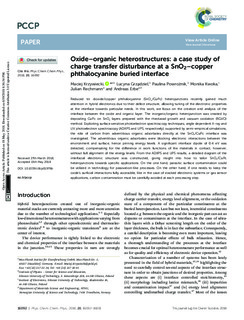| dc.contributor.author | Krzywiecki, Maciej | |
| dc.contributor.author | Grządziel, Lucyna | |
| dc.contributor.author | Powroźnik, Paulina | |
| dc.contributor.author | Kwoka, Monika | |
| dc.contributor.author | Rechmann, Julian | |
| dc.contributor.author | Erbe, Andreas | |
| dc.date.accessioned | 2018-06-21T08:27:00Z | |
| dc.date.available | 2018-06-21T08:27:00Z | |
| dc.date.created | 2018-06-19T22:06:22Z | |
| dc.date.issued | 2018 | |
| dc.identifier.citation | Physical Chemistry, Chemical Physics - PCCP. 2018, 20 16092-16101. | nb_NO |
| dc.identifier.issn | 1463-9076 | |
| dc.identifier.uri | http://hdl.handle.net/11250/2502408 | |
| dc.description.abstract | Reduced tin dioxide/copper phthalocyanine (SnOx/CuPc) heterojunctions recently gained much attention in hybrid electronics due to their defect structure, allowing tuning of the electronic properties at the interface towards particular needs. In this work, we focus on the creation and analysis of the interface between the oxide and organic layer. The inorganic/organic heterojunction was created by depositing CuPc on SnOx layers prepared with the rheotaxial growth and vacuum oxidation (RGVO) method. Exploiting surface sensitive photoelectron spectroscopy techniques, angle dependent X-ray and UV photoelectron spectroscopy (ADXPS and UPS, respectively), supported by semi-empirical simulations, the role of carbon from adventitious organic adsorbates directly at the SnOx/CuPc interface was investigated. The adventitious organic adsorbates were blocking electronic interactions between the environment and surface, hence pinning energy levels. A significant interface dipole of 0.4 eV was detected, compensating for the difference in work functions of the materials in contact, however, without full alignment of the energy levels. From the ADXPS and UPS results, a detailed diagram of the interfacial electronic structure was constructed, giving insight into how to tailor SnOx/CuPc heterojunctions towards specific applications. On the one hand, parasitic surface contamination could be utilized in technology for passivation-like processes. On the other hand, if one needs to keep the oxide's surficial interactions fully accessible, like in the case of stacked electronic systems or gas sensor applications, carbon contamination must be carefully avoided at each processing step. | nb_NO |
| dc.language.iso | eng | nb_NO |
| dc.publisher | Royal Society of Chemistry | nb_NO |
| dc.rights | Navngivelse 4.0 Internasjonal | * |
| dc.rights.uri | http://creativecommons.org/licenses/by/4.0/deed.no | * |
| dc.title | Oxide – organic heterostructures: a case study of charge displacement absence at a SnO2 – copper phthalocyanine buried interface | nb_NO |
| dc.type | Journal article | nb_NO |
| dc.type | Peer reviewed | nb_NO |
| dc.description.version | publishedVersion | nb_NO |
| dc.source.pagenumber | 16092-16101 | nb_NO |
| dc.source.volume | 20 | nb_NO |
| dc.source.journal | Physical Chemistry, Chemical Physics - PCCP | nb_NO |
| dc.identifier.doi | 10.1039/C8CP01976B | |
| dc.identifier.cristin | 1592461 | |
| dc.description.localcode | Open Access Article. Published on 18 May 2018. This article is licensed under a Creative Commons Attribution 3.0 Unported Licence. | nb_NO |
| cristin.unitcode | 194,66,35,0 | |
| cristin.unitname | Institutt for materialteknologi | |
| cristin.ispublished | true | |
| cristin.fulltext | original | |
| cristin.qualitycode | 2 | |

